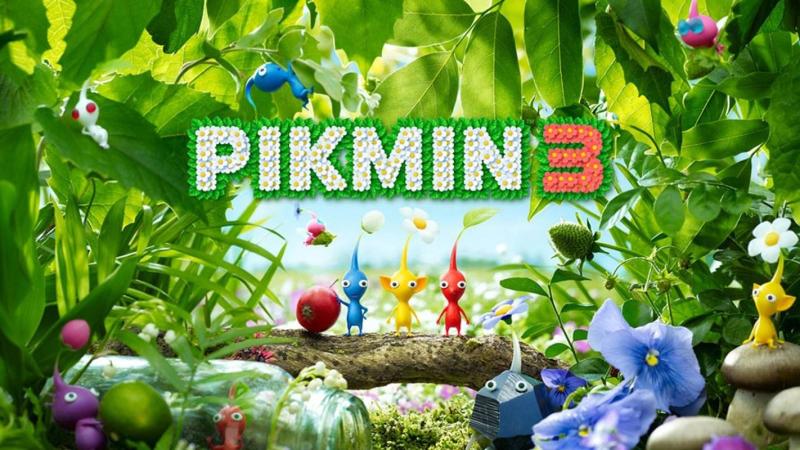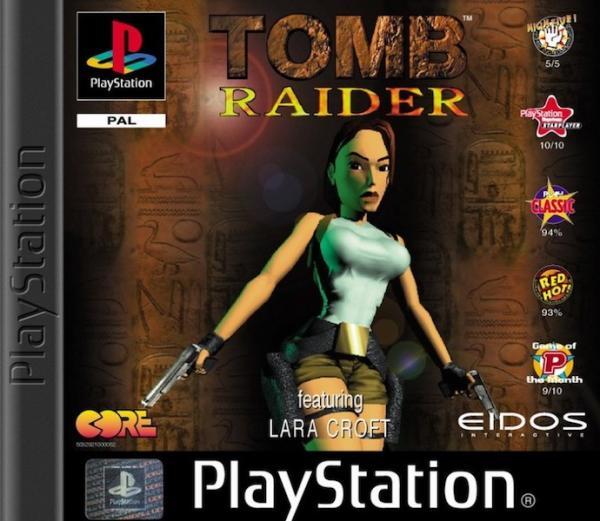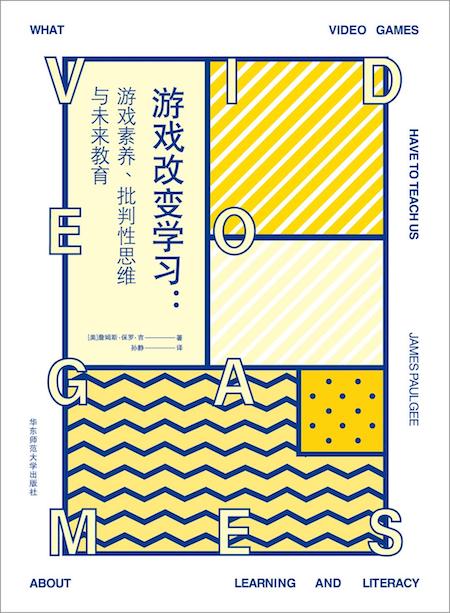Can games be an effective way to learn, and how should we perceive the learning function of games?
The University of Wisconsin-Madison professor James Paul Gee’s book Game-Changed Learning: Game Literacy, Critical Thinking, and the Future of Education provides a model for discussing the relationship between games and learning. For him, a game is a well-designed learning experience in which you can identify problems, understand them, and solve them.
The true potential of the game has yet to be tapped.
"The" sense of play "is everywhere"

The game Pikmin 3.
When it comes to video games, many people’s first reaction is to be addicted and unable to withdraw. They believe that online games can easily lead to negative problems such as declining academic performance or reduced work efficiency, poor eyesight, and withdrawn personality. Is this our misunderstanding of games?
James Paul Gee (author of Games Change Learning: Game Literacy, Critical Thinking, and Education for the Future): People become addicted to anything that brings pleasure, especially when it makes up something that is not there in life. However, pleasure is an important human driver. Without pleasure, one would not want to learn.If we need to deal with a variety of addictive behaviors, we need to identify what the addict is missing in real life and help them find it.In addition, we also need to learn how to make powerful technologies benefit lives rather than harm them.
When my son Sam was six years old, he played a game called Pikmin, which was designed by Shigeru Miyamoto in 2001. You may not know who Shigeru Miyamoto is, but his masterpiece is the famous Super Mario. In Pikmin, the player takes on the role of Captain Olima, whose spaceship crashes to an unknown planet due to a comet impact. Olima can only survive for 30 days, and within 30 days, he must find the missing spaceship parts and escape from the planet. The game sounded interesting, but after watching his grandson play for a few hours, Sam’s grandfather commented, "Although it may be good for the child’s eye-hand coordination, it’s a waste of time because the game has nothing worth learning."This is also a typical misconception that important knowledge is often gained from the subjects taught in schools, and the rest is just "meaningless entertainment". But in fact, games can also generate knowledge.
Jing Sun (Translator of "Games Change Learning: Game Literacy, Critical Thinking, and Future Education"): From the perspective of consumption, in our traditional culture, games and work learning are a set of binary opposing expressions, and this evaluation of traditional games has more or less influenced people’s views on digital games. From the perspective of production, although people currently know that games can play serious functions other than entertainment, and can be used in various scenarios such as education and medical care, there are very few such game products, and the public does not have much access to such games.
Furthermore, contemporary attitudes towards games are mainly divided into "addiction school" and "addiction school". It is obvious that the "addiction school" misunderstands games and advocates that all games are bad. On the contrary, the "addiction school" exaggerates the entertainment function of games and believes that all games are good.Both views are also generational differences between "digital natives" and "digital refugees," but both views are misconceptions of gaming, and ultimately a lack of adequate game literacy.
Upper Study: Game literacy is a very important concept proposed by Professor Ji in the book. What is game literacy?
James Paul Gee: When people play video games, they are learning a new kind of literacy. As an important part of digital literacy, game literacy is not just the ability to understand the game or play the game, but the ability of the player as an active participant to "control" the game symbol system in turn. In the process of playing, the player can not stop at "input" – one-way passive acceptance of the game content, but also be able to "output" – active and critical gaming experience.
In the book, I distinguish between "lowercase games," which are the software you play, and "uppercase games," which are not just the software but also the social interactions and social resources that go with it, so that players can put the game into a social context, go beyond the game itself and reflect on it, discuss it, and even modify it.What we should be focusing on is "capital games," that is, games and all the social elements associated with them. Now, players make this very clear.
Sun Jing: As far as the term "game literacy" is concerned, Professor Ji has laid a solid theoretical foundation for this concept from the perspective of linguistics and pedagogy, which is also the biggest gain I have gained from translating this book. I believe that game literacy is an active and critical game experience. One is the ability to read games, emphasizing the evaluation of games for specific game works, and to understand games in specific social and cultural contexts. The other is the ability to use game writing, that is, to modify and create games, and eventually to use games to express themselves.
When it comes to reading and writing, we usually think of words. Can games become the same medium as words?
Sun Jing: Of course, and it has already happened. In short, game thinking is a way of thinking that solves problems through trial and error, with initiative, exploration, and criticism.Today’s young people are all "game generation", growing up in the infiltration of games. Through games, they can understand traditional media such as literature, television, film, painting, etc. It can be said that the "sense of game" is everywhere, becoming a way for them to understand the world.
James Paul Gee: We’ve known for a long time that people can learn from all kinds of media experiences, just as they learn from real-world experiences. It’s true that sometimes they can’t remember whether what they’re learning came from the real world or from a medium. Games are also gradually becoming a medium like books, and have a deeper impact on people than books. In other words,Books can tell us what an electron is, but games can make us an electron.
"The Secret of the Game"

Laura in the game Tomb Raider: The Last Revelation.
Upper Study: Not everyone who plays games is successful in translating the advantages that come from gaming into their daily lives. What’s going on with some deep gamers who benefit from gaming, while others run into trouble?
James Paul Gee: The same is true for books. What you get out of a book depends on what you read, how you read it, and who you read or discuss with. Compared to other types of reading, a romance novel may not be "spiritual food for thought and practice."But if you read it with a critical perspective and "read it like an author," thinking in your head how to use it, how to change it, how to make it a spiritual imagination, then novels like this can also pay off.
Sun Jing: This is still related to game literacy. If you passively accept the content conveyed by game producers and game works, then players will still have nothing to gain except entertainment pleasure. Even hard-core players, some people are just immersed in the game, excessive consumption of time and money, affecting real life; while others may repeatedly refine strategies, optimize tactics, and become world esports champions. If you want to gain something from the game, you must have enough critical thinking and game literacy, be able to understand the game, and more advanced, be able to use the technical language of the game to solve real life problems.
Upper Study: Whether it is learning or gaming, difficulty and skills are the key parameters. In games, it is very common to not give up even if you are turned into a slag in seconds, and it is very common to not sleep until you complete the level. Why can players enjoy immersing themselves in the game, but be hesitant to learn?
James Paul Gee: This can be called the secret of games. I’ve played a lot of games and found that a good game has a characteristic: almost every problem has multiple solutions. Players can choose strategies that suit their learning, thinking, and acting styles, which is a great motivator and a rich resource for reflecting on their behavior and problem-solving. I wrote this book to help people uncover this secret, find effective ways to coordinate game skills and task difficulty, and then apply the corresponding game thinking to learning to make learning fun and effective.
Upper Study: Professor Ji mentioned in the book that one of the spiritual cores of the game is critical reflection. How is criticism reflected in the game?
James Paul Gee: I had this experience in the game Tomb Raider: The Last Revelation. You play as Lara, a teenage girl, who follows an archaeologist, Professor von Croix, on an expedition through a Cambodian temple. The professor once told Lara to follow him and not stray from his path. But I found that if you follow the professor’s orders, you risk missing out on a lot of hidden treasure. Good games have a mechanism that encourages players to try, question and break the rules, and such experiences not only enhance the fun of the game, but also cultivate critical thinking.In this way, players no longer rely on various operation guides, get rid of the established routine of completing tasks, and even jump out of the rules. They will also reflect on the values that the entire game mechanism has shaped.
Jing Sun: It can be said that critical reflection underpins game thinking. In fact, critical reflection may not have been ubiquitous in the general public at every stage of history, from Plato’s "The Parable of the Cave" to Kant and Foucault’s "What is Enlightenment". At present, people are faced with too much information, and the discourse of power operates in more subtle ways in daily life, which can also affect the way some people understand the world. Because of this, we need to emphasize the cultivation of critical thinking.
James Paul Gee: Just to add that critical thinking is not the same in different fields of knowledge and practice, for any branch of science, law, game design, or gardening. Critical thinking involves understanding how to make and use knowledge, principles, and methods in a given field to discover, to criticize, and to solve problems. In order to produce critical thinking in any meaningful dimension, we need to teach people how to acquire knowledge in that field, for example, the spread of viruses, the nature of video games, or the role of government, and how to use that knowledge to cooperate with people to solve problems and reach effective criticism,The purpose of criticism is to construct, not to destroy. We need to use knowledge as a tool, not rote for exams.
"The game is always changing."
But the problem we have to face is that the game industry is mixed, and not all games are suitable for teenagers. What kind of digital games can have great appeal and practical benefits for children?
James Paul Gee: Like choosing a book, teenagers are left to decide on their own which games are good. In any case, we want teenagers not to jump in without thinking, but to think like designers and ultimately learn to "design" their lives with their own experiences, using a variety of different tools and effective ways to become good people. They will also become teachers and parents, and hopefully they will be able to "design" quality experiences for their children and students.
We can learn from games that schools should not be designed as warehouses of past knowledge, but as a source of imagination that can make life and society better.
Jing Sun: The quality of game works is uneven, which is normal, because novels, movies and other art works also have the same problem. Teenagers are still in the stage of exploring the world and learning to learn, so it is not suitable for game products that emphasize consumption. Consumption here includes both money consumption and time consumption. Therefore, video games that emphasize exploration and creation with one-time payment are more suitable for teenagers to play.
As for how we can learn from good video games to design learning models and education systems, Professor Ji gives a detailed answer in the book. He lists 36 principles, including building situations, encouraging exploration, and understanding fun groups. This kind of education can not only make children feel interesting and learn knowledge, but more importantly, it can cultivate their way of thinking, which will benefit them for life.
The current challenge we are facing is how to use the unique projective identity of games to construct meaningful "second classrooms" outside of school education and in the game world. This poses a challenge to current game design. Can we change the crude way of mass production of games that look at money, and make games that are not only formal and slogans, but also thought-provoking?
James Paul Gee: I talk a lot about projected identity in my books. Projected identity in a video game is when the player projects their identity on a virtual character or stand-in, performing some form of action, and the player accepts the stand-in’s values, goals, and identity.I believe that we are also adapting to our new identities in the real world in the same way. If we want to learn science, we need to accept being a scientist before we can really use scientific knowledge in depth.
Developing a science game is easier for students to experience as a scientist than learning, at least in the United States. In reality, however, schools can do the same if the school space is properly adjusted to have a strong interaction with the world outside the school, the virtual world, the simulation world and the game world.
We need to change not only the profit-driven approach to the mass production of games, but also current classroom teaching and schooling to develop problem-solving strategies and plan for an entirely new future. In the United States, this often stems from the need for standardization and profit in the textbook industry, at the expense of critical thinking and problem-solving. Putting multiple design technologies (including literacy) at the service of design thinking, problem-solving in deep collaboration, and ensuring that we all serve in a rapidly changing, high-stakes complex world will only get better when people discover the importance of this approach. For now, we must pay more attention to the future and use the past to imagine the future, otherwise we humans will not have the future.
Driven by the digital revolution, new technologies such as virtual reality (VR), augmented reality (AR), and artificial intelligence (AI) are changing the learning environment. Will games under the new technologies affect people’s learning ability more deeply?
James Paul Gee: It’s critical for people to realize that digital games are a very cutting-edge and rapidly changing technology. If you compare games from 1995 to games today, there are a lot of differences between the two. New game genres are being discovered and made. The types of games we’ve made, maybe only 1% of future games, still have a lot of room for imagination and creativity. Games are always changing, and this trend will continue as games merge with other technologies like VR, AR, and AI. Emerging social games and cooperative games will also be developed. This is a powerful technology that is undoubtedly critical to economic, cultural, and even social development.
People need to realise that when it comes to books, most of what they hear are "bestsellers". However, there is an important and growing industry of indie games that make games from the fields of art, medicine, design, science, collective intelligence and more. Above all, it is important to realise what digital game technology really means. It is a virtual imagination, based on important choices, strategic thinking and learning from failure. It is also an external active imagination, based on well-designed and carefully directed virtual experiences that allow players to merge their identity with real-world experiences.
Sun Jing: I also think that the answer is yes. In the real world, learning resources and feedback cycles are limited, and games can create more diverse and rich learning scenarios by simulating reality and fiction. For example, there are VR games that specifically train medical students to perform surgery, which can provide operators with real-time feedback and accurately complete surgical training.
Good games typically convey knowledge and shape people’s way of thinking, while good educational games can also stimulate interest in learning, create a more immersive learning environment, and provide a more fulfilling formative evaluation.With them, you and I can not only become the "number one player", but also benefit our future learning and lifelong education.

"Games Change Learning: Game Literacy, Critical Thinking, and the Future of Education"
?By James Paul Gee
Translated by Sun Jing
East China Normal University Press
关于作者